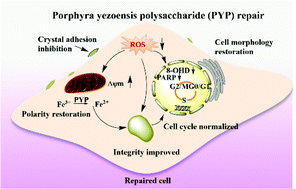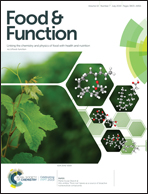Repair activity and crystal adhesion inhibition of polysaccharides with different molecular weights from red algae Porphyra yezoensis against oxalate-induced oxidative damage in renal epithelial cells
Abstract
Renal epithelial cell injury is a key step in inducing kidney stone formation. However, research on the role of cell repair in the prevention and treatment of kidney stones is limited. In this study, the repair effect of degraded Porphyra yezoensis polysaccharide (PYP) on oxidative stress-mediated intracellular damage triggered by oxalate in human kidney proximal tubular epithelial (HK-2) cells was investigated, and the influence of molecular weight (Mw) on the repair ability of PYP was elucidated. Polysaccharides with different Mws were prepared by degrading PYP with hydrogen peroxide. Four degraded fractions, namely, PYP1, PYP2, PYP3, and PYP4, were successfully obtained with Mws of 576.2, 49.54, 12.65, and 4.020 kDa, respectively. A damaged cell model was established using 2.6 mmol L−1 oxalate to injure HK-2 cells. Various Mws of PYPs were used to repair the damaged cells. The repair mechanism of PYPs against oxalate-induced oxidative stress was examined by evaluating cell proliferation and physiological function recovery. Our study revealed that PYPs increased the viability of oxalate-injured HK-2 cells and restored their morphological characteristics and cytoskeleton. PYPs reduced the levels of oxalate-mediated lactase dehydrogenase release, reactive oxygen species generation, and intracellular Ca2+, the loss of mitochondrial membrane potential, the number of cells arrested in S phase, the expression of 8-hydroxy-desoxyguanosine and poly ADP ribose polymerase, lysosomal damage, and the number of apoptotic cells. The PYP fraction with low Mw presented an increased repair activity against cellular damage induced by oxalate. The resistance of the repaired renal cells to crystal adhesion and aggregation was stronger than that of the damaged cells. PYPs might inhibit the formation of kidney stones by repairing damaged cells and inhibiting crystal adhesion and aggregation. We concluded that PYP with low Mw could be used as a potential therapeutic agent against renal stone formation and recurrence.



 Please wait while we load your content...
Please wait while we load your content...